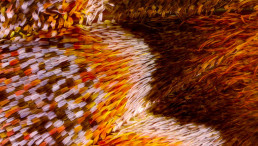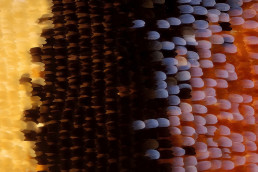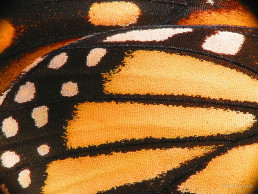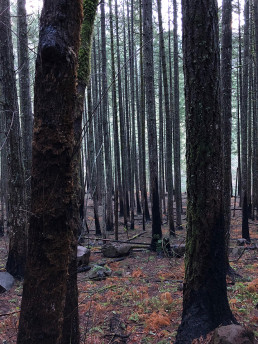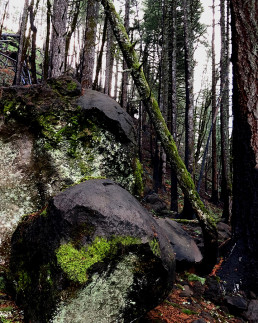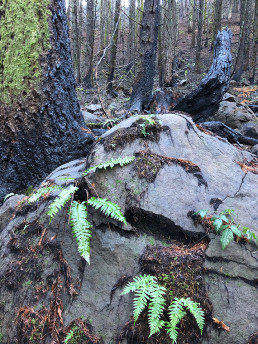How We Win | Divestment and Nonviolent Direct Action
How We Win | Divestment and Nonviolent Direct Action
In 2009 a group of Quakers concerned about climate and economic justice gathered in a Philadelphia living room. The group was looking to start a campaign that would be significant for people and the planet – yet, at the same time, would be winnable.
 We had heard about the practice of blowing up Appalachian mountains for coal – 500 mountains had already been leveled. The coal companies found they could save on labor by using dynamite and heavy machinery to extract the coal by taking down the mountain, layer by layer.
We had heard about the practice of blowing up Appalachian mountains for coal – 500 mountains had already been leveled. The coal companies found they could save on labor by using dynamite and heavy machinery to extract the coal by taking down the mountain, layer by layer.
The resistance movement of Appalachian people had few allies outside the region. Mountaintop removal coal mining was the latest of a string of abuses of the Appalachian people by the coal companies. It reduces the number of jobs available in the coalfields, while increasing rates of cancer and birth defects. Maybe, we reasoned, we could help tip the scales with our campaign and assist the long-suffering Appalachian people.
We knew that banks need to loan money to coal companies so they can blow up the mountains, and we discovered the number one perpetrator of this practice. But we knew nothing about organizing a campaign that targeted a bank. In fact, most of our group had never before joined a nonviolent direct action campaign.
Nevertheless, since others had done campaigns, we figured we could learn from them and add our own creativity.
One reason to target a bank was the interface between the climate crisis and the economy. We observed that the economic class that sets the direction for the U.S. refuses to accept responsibility for climate consequences. The 2008 Wall Street disaster only underlined this reality and the culpability of banks in the broader disaster. By pressuring a bank to take responsibility for the consequences of its practices, we would be pushing a higher standard of behavior.
On the other hand, we were just a living room full of people and the primary source of financing for mountaintop removal was PNC Bank – the seventh largest in the U.S.! Could we make a difference? We needed to research and identify the bank’s vulnerabilities.
The bank spent time on college campuses in the first weeks of the fall reaching out for new customers among the students who were away from home for the first time. We simply showed up on those campuses, stood next to the bank’s sales booth, and pointed out to the students what their deposits would be used for.
In the bank branches, the tellers and even the branch managers had no idea what the bank was doing with depositors’ money. Of course we went into the banks and told the customers, but we also told the tellers and managers. Soon the memo came from corporate headquarters in Pittsburgh: DO NOT READ ANYTHING BY EARTH QUAKER ACTION TEAM! We quickly learned that our presence in bank branches did indeed quake their earth.
We escalated by sitting in a circle on the floor to sing and pray and testify about what we’d seen in Appalachia. This disrupted the bank operations so they called the police. An increasing number of us were arrested, crossing a threshold that most our members had never imagined crossing. It strengthened our courage and more people joined our group, which we nicknamed EQAT.
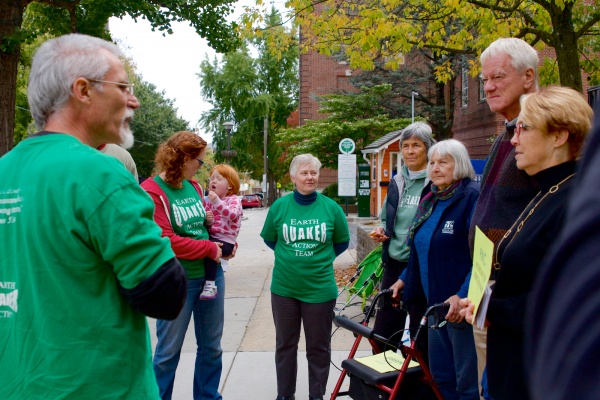
Over time we were able to disrupt two bank branches in adjoining towns on the same day, then two states, and then three or more. The bank began to surveil us to learn where we would turn up next, a practice we proudly bragged about: “This huge bank stoops to spy on us: we must be more powerful than we thought!”
The bank surveilled us to be able to close its banks when we were due to arrive, locking their doors against their own customers! We declared victory each time, realizing our new members of our still-small but growing campaign had more power than they knew!
I found myself, at 76, walking 200 miles across Pennsylvania to PNC’s headquarters city, Pittsburgh. Our group stopped at local branches along the way, doing our actions and asking: “Would the senior officers of PNC walk 200 miles to demonstrate their deeply-felt conviction that destroying the climate and injuring people was an OK way to make a living?”
None of the officers stepped forward to “put their skin in the game.” We weren’t surprised: we’d been meeting with bank officers all along, and none of them was able to justify the bank’s practice.
We continued to research the bank and learned that members of their board of directors were often honored by a hometown chamber of commerce or other group. We began to show up on those occasions, paying to attend the banquet or reception, and then speaking out loudly during the ceremony to tell those attending what they didn’t know: the honoree was receiving payments for their role in a bank that blew up mountains and gave people cancer!
On our website we kept a running count of the amount of money that bank depositors told us they transferred from PNC to credit unions and community banks. The total reached five million dollars by the time we won.
After two years attending national shareholder meetings and waiting patiently for the Question and Answer part of the agenda, we escalated by disrupting the meetings and shutting them down. Our action inside the meetings was simple: telling the truth about the bank’s actions, loudly — a truth the bank did not want its shareholders to feel in a way that would reach their consciences.
After EQAT’s campaign of five years and 125 actions, the mighty bank finally announced to the world that it was giving up financing mountaintop removal coal mining. Within a week, Barclay’s Bank in the UK – the banking giant of the British Commonwealth – announced that it, too, was abandoning the practice. The beautiful Appalachian mountains have been largely undisturbed since.
Our campaign grew from that West Philly living room to 13 states. The new activists had given themselves some important resources: an internal coach with prior experience, an external consultant who also had previous experience, and the willingness of Rainforest Action Network to be our “big sister.”
The good news is that a small group can take on a big goal if its members focus their energy, adopt nonviolent direct action as their means, develop a steep learning curve, attract new members, sustain and escalate their actions, and support each others’ spirits.
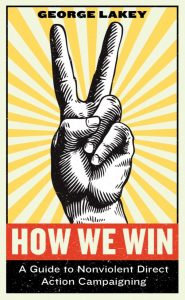
Excerpted from How We Win: A Guide to Nonviolent Direct Action Campaigning by George Lakey, published by Melville House (Brooklyn and London), 2018.
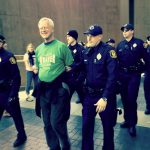
About George Lakey
George Lakey recently retired from Swarthmore College, where he was Eugene M. Lang Visiting Professor for Issues of Social Change. He has led over 1500 social change workshops on five continents. How We Win is his tenth book on change and how to achieve it.
The Treasure of Our Living, Relational Commons
The Treasure of Our Living, Relational Commons
As I have learned about the social life of trees and the intimate bonds that indigenous peoples have with various lifeforms and rivers – and as I pore through recent ecophilosophy that explains aliveness to the western mind — I’ve concluded: We really ought to be talking more about animism and commoning.
Scientific rationalism and economistic thinking may be the dominant forces of our time, but they aren’t so good at creating social purpose and meaning. Which may help explain why evidence of a new animism keeps popping up as a way to re-enchant the world, often finding its voice through commoning. This should not be too surprising, suggests ecophilosopher Andreas Weber, because the biology of life points to an understanding of reality itself as a commons.
Commons are realms of life defined by organic wholeness and relationality. They stand in stark contrast to a modern world whose hallmark is separation — the separation of humans from “nature”; of individuals from each other; and a separation between our minds and our bodies.
To be sure, animism has a problematic history. Early anthropologists generally projected their own worldviews onto tribal peoples, denigrating them as backward. As staunch Cartesians and moderns, they saw body and mind as utterly separate. So anyone who ascribed a living presence to animals, mountains and natural forces could only be seen as “primitive” and “superstitious.”
But today’s animism (as seen through western eyes) is different. It sees the experience of life as a dynamic conversation among the creatures and natural systems of the Earth. It is about surrendering an anthrocentric vision and seeing the world as “full of persons, only some of whom are human,” in which “life is always lived in relationship with others,” as religious studies scholar Graham Harvey has put it. Animism is “concerned with learning how to be a good person in respectful relationships with other persons.” It resembles the “I-thou” relationship of respectful presence proposed by theologian Martin Buber.
For me, two recent readings have brought animism into sharper focus. The first is a piece in The Guardian by British nature writer Robert Macfarlane (November 2, 2019) that points to “new animism” on the rise. He starts by mentioning a number of “rights of nature” laws that have been enacted around the world. Ecuador and Bolivia are the most famous cases, but did you realize that the City of Toledo, Ohio – on the banks of Lake Erie – approved a referendum in 2019 that gives “legal personhood” to that troubled lake? Lake Erie now joins the Ganges and Yamuna rivers in India and the Whanganui River in New Zealand in enjoying legal standing in their respective nation-states.
Macfarlane explains the significance of the Lake Erie Ecosystem Bill of Rights:
Embedded in the bill is a bold ontological claim – that Lake Erie is a living being, not a bundle of ecosystem services. The bill is, really, a work of what might be called “new animism” (the word comes from the Latin anima, meaning spirit, breath, life). By reassigning both liveliness and vulnerability to the lake, it displaces Erie from its instrumentalised roles as sump and source. As such, the bill forms part of a broader set of comparable recent legal moves in jurisdictions around the world – all seeking to recognise interdependence and animacy in the living world, and often advanced by indigenous groups – which have together come to be known as the “natural rights” or “rights of nature” movement.
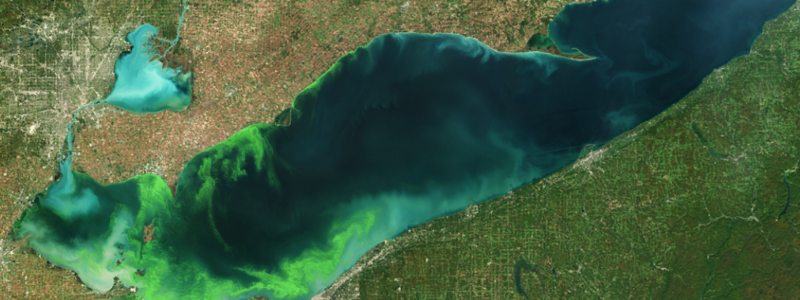
Macfarlane goes on to say that a “’radical re-storying’ is presently under way across culture, theory, politics and literature, as well as law” that can be seen in “the creative protests of Extinction Rebellion; in the “new animist” scholarship of Isabelle Stengers, David Abram and Eduardo Kohn” and the work of Robin Wall Kimmerer. I would add the ecophilosophy of Andreas Weber (“Biology of Wonder” “Matter and Desire”) and Stephan Harding (“Animate Earth”).
All these efforts, says Macfarlane, “seek to recognise something we had turned away from: that is to say, the presence and proximity of nonhuman interlocutors,” in the words of Amitav Ghosh.
I have also been quite taken by Eduardo Kohn’s 2013 book How Forests Think: Toward an Anthropology beyond the Human. Kohn boldly asks the modern mind to show humility in how it thinks about and represents “nature.” It asks that we try to see the more-than-human world as a vast living system of “biosemiotics” – embodied, living organisms that are constantly creating meaning as they interact with each other.
Kohn warns that we moderns are “colonized by certain ways of thinking about relationality…. Without realizing it we attribute to nonhumans properties that are our own, and then, to compound this, we narcissistically ask them [nonhumans] to provide us with corrective reflections of ourselves.”
So in our modern world of separation, we assume that “nature” is all about individuals striving to survive a dog-eat-dog market competition, ignoring the deep symbiosis and cooperation that is a major part of all biological life. We also assume that the natural world is inert, unfeeling, and without meaning – a mute backdrop for the drama of humankind.
Kohn spent four years doing ethnographic fieldwork among the Runa of the Upper Amazon in Ecuador, an experience that forced him to rethink the meaning of “real.” He brilliantly argues that our planet is alive, literally, and therefore we humans, as biological beings, are deeply implicated in “a complex web of relations that [he calls] an ‘ecology of selves.’”
Whether an organism presents as a threat to others, a sometime-cooperator, or a distant support through the landscape, living creatures must always invent a “self.” The whole process of generating and sustaining living selves creates “meaning” embodied in the shape, behavior, and expression of an organism. Or as Kohn puts it, “All life is semiotic and all semiosis is alive.” Life and meaning cannot exist without each other.
Hence the explanation for the book’s title. Kohn argues that forests think as its constituent living organisms interpenetrate each other in highly complicated ways, giving rise to an ecosystem of selves, whether plants or animals or microorganisms.
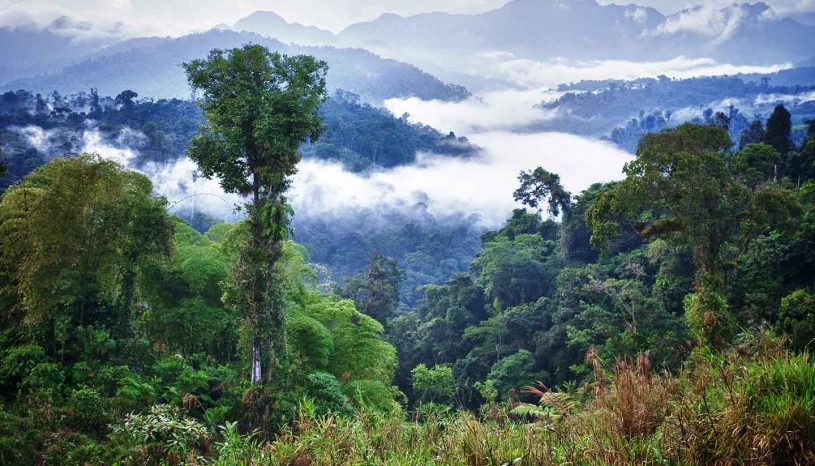
That’s what is so difficult for we moderns to understand — the aliveness and relationality that pervades our planet! It’s not just humans who are alive and having thoughts. All sorts of living organisms are creating selves and meaning, independent of human observation and activity. “The rain forest, writes Kohn, is “an emergent and expanding multilayered, cacophonous web of mutually constitutive, living, and growing thoughts.”
The question is, Can we tune into that frequency, the “vast ecology of selves” that are inscrutable to modern epistemologies and ways of knowing? Can we moderns allow ourselves to enter into the logic of how forests think? Can we learn to see the relations between plants and soil, for example, or between human and jaguar, as forms of living representation and meaning, even if they lie beyond linguistics?
We are so accustomed to seeing ourselves as separate and apart from “nature” – as the apex predator that can reshape “nature” however we wish – that we have trouble situating ourselves within the flows and constraints of a living planet. We presume to be masters of “nature” – a presumption ratified by language itself. Western cultures have a strong preference for using generic, abstract nouns whereas indigenous cultures tend to use precise verbs that name relationships and interactions with living systems. Indigenous languages reflect the idea that “there exist other kinds of thinking selves beyond the human.”
Free, Fair and Alive: Relationality as the core of commoning
I resonate to the new animism because, like the commons, it is about honoring relationality as a core reality of life. That’s a theme that Silke Helfrich and I develop in our new book Free, Fair and Alive: The Insurgent Power of the Commons (New Society Publishers). We offer a foundational reconceptualization of the commons as a living social system, moving away from the standard narrative of commons as “unowned” economic resources.
From cohousing and agroecology to fisheries and land trusts and open-source everything, people around the world are increasingly turning to “commoning.” They see it as a way to emancipate themselves from a predatory market/state system. They see commons as a way to enter into enduring relationships with each other, and to escape the often-predatory and destructive character of what we call the market/state system. Markets and nation-states are not so much adversaries as joint partners in a system based on ceaseless economic growth and technological innovation, an inability to set limits on the exploitation of natural systems, and the private appropriation of our shared wealth and planet.
We see the commons as a way to help re-think the very meaning of “the economy” and to validate the importance of ecological stewardship, care work, and social cooperation. But since so much discussion about the commons relies on the very discourse of modern economics, we came to see that the commons needs to be reinterpreted. The commons needs to be understood as relational and alive. We try to explain this reality through the Triad of Commoning, which describes the relationships that lie at the heart of social life, peer governance, and provisioning in a commons.
Our book is a rare inquiry into commoning – the verb, the social practices, the moral relationships – which is quite different from the commons — the noun, seen as resources and their exchange value. The further that my coauthor Silke and I got into studying and rethinking the commons, the more we realized that prevailing categories of thought are simply too reductionist to capture what is really going on within actual commons.
Standard economics, property law, and policy assume the reality of rational, autonomous individuals, as reflected in the idea of homo economicus, the philosophy of modern liberalism. These disciplines presume a separation of humanity and “nature.” But we regard these assumptions as fundamentally misleading. They fail to understand humanity in a biological sense. We humans are all inscribed within larger collectives – ecological, cultural, political – that make us who we are. It’s time that we began to acknowledge that life is far more relational than transactional.
Commoning is all about the peer construction of relationships, including with the large ecosystems in which we live. Fortunately, the new “rights of nature” laws, scholarly literature on animism, and the proliferation of countless commons are fueling the great OntoShift that is needed. Aliveness and the relationality that makes it possible are starting to get their due recognition.
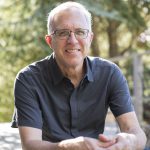
About David Bollier
David Bollier is an American activist, scholar, and blogger who is focused on the commons as a new/old paradigm for re-imagining economics, politics, and culture. The commons is as old as the human race but newly discovered, too, as the Internet, open source software, alternative currencies, and platform co-operatives. Bollier pursues his commons scholarship and activism as Director of the Reinventing the Commons Program at the Schumacher Center for a New Economics (Massachusetts, US), and as cofounder of the Commons Strategies Group, an international advocacy project. He is particularly focused on the role of commons in re-imagining local economies to empower community self-reliance, prevent market enclosures, and anticipate the coming disruptions of climate breakdown and Peak Oil.
Soil Wealth and a Regenerative Green New Deal
Soil Wealth and a Regenerative Green New Deal
“Ultimately, we need to transform finance and shift the flow of investment capital to perpetuate a Regenerative Economy that serves humanity and is a steward of Earth’s ecosystems.” – John Fullerton and Hunter Lovins, “Creating a Regenerative Economy to Transform Global Finance into a Force for Good”
At the present time, trillions of dollars are invested in the industrial, “conventional” global food system, a system with annual sales to consumers of $7.55 trillion. This system is artificially propped up by hundreds of billions of dollars in annual government subsidies, sustaining energy-intensive, chemical-intensive, GMO-driven agriculture and food processing. The massive external costs and damages of the conventional food system—that is, degeneration of the environment, public health, and climate stability—are hidden from citizens, taxpayers, and investors alike (in other words, those who will eventually pay the bill for this collateral damage), with “true costs” never included in the bottom line. If true cost accounting were required, massive amounts of capital would move out of industrial food, farming, and land use into more productive sectors such as organics, holistic grazing, agroforestry, and agroecology. Unfortunately, very little money, relatively speaking, is currently invested in the organic, agroecological, and regenerative sector. According to one recent study, there is already approximately $321 billion invested in regenerative, “soil wealth” enterprises and projects—but that amounts to just a little over 1 percent of current global liquid assets.
Meanwhile, investors, pension managers, mutual funds, sovereign funds, and even so-called ‘green’ or socially responsible funds that have begun to shun fossil fuel investments continue to pour money into climate-degrading, chemical-intensive food, factory farm, and commodity corporations, GMOs, patented seeds, and most recently “Big Data.” In the agribusiness market “Big Data” includes high-tech tools of soil, climate, weather, crop, markets, and chemical inputs analysis, utilizing computers, satellite data, drone photography, sophisticated farm machinery and other techniques to supposedly increase yields and profits on modern farms.
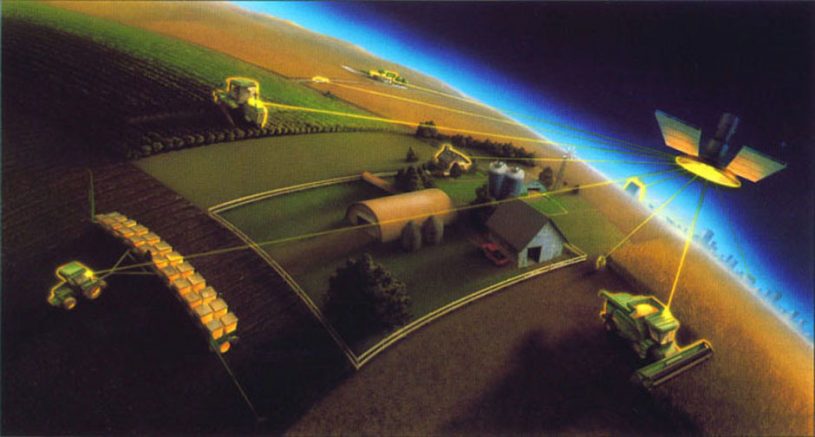
How do those of us who are not fundamentally business-minded nor trained in soliciting investments become more adept and sophisticated in obtaining funding to scale up our regenerative economy? How do we prove to investors that there is a strategic, indeed existential imperative to consider investments that not only are socially responsible and good for the environment but also build the essential new regenerative economy?
Growing up in a decidedly working-class family, spending summers on my grandparents’ small family farm, and then waging campaigns for most of my adult life against corporations like Monsanto and other “bad guys in suits,” I must admit that it has been a stretch for me to finally accept the fact that businesspeople and investors will have to become important drivers of Regeneration. I’ve always felt somewhat uncomfortable around the East and West Coast MBA types who run the foundations that give out money, if you’re lucky, to public interest activist groups like the Organic Consumers Association. I feel out of place in corporate offices and settings. I feel strange in a suit and tie. I feel more comfortable in the Minnesota North Woods, or at our high desert farm school in Mexico, than I do in the city. Our Minnesota office and agroecology farm is located in a town called Finland, population three hundred. Six miles away, I live with my wife and my son in a cabin, yurt, and straw-bale office in the middle of the woods; for our first ten years here, we had no running water. The closest village to our organic farm and conference center in Mexico is called Membrillo, and it’s too small to even be on the map.
But the time has come for old hippie back-to-the-landers like myself, and for everyone else who cares about the climate and the survival of civilization, to not only step up our campaigning but become more entrepreneurial in our thinking and activism as well. After spending decades struggling to make ends meet while working in, and later directing, financially strapped not-for-profit organizations, cooperatives, activist campaigns, and a number of organic small farms and businesses, until recently I’d never sat down with a real investor, as opposed to a philanthropist (someone from whom I was asking for a tax-deductible donation), and talked about why they should invest money in a regenerative enterprise.
Despite writing hundreds of grant applications and raising millions of dollars every year—usually the hard way, via $25 to $50 donations from members and supporters—until recently it never occurred to me to solicit investors for a business venture separate from the nonprofit sector that could advance the regenerative economy. It never occurred to me to approach the handful of large donors who have always supported organics to become investors in a common endeavor that could advance our common concerns and still generate a fair return to them as investors. But recently I’ve started moving in this more entrepreneurial direction, as have a growing number of others in our global Regeneration movement.
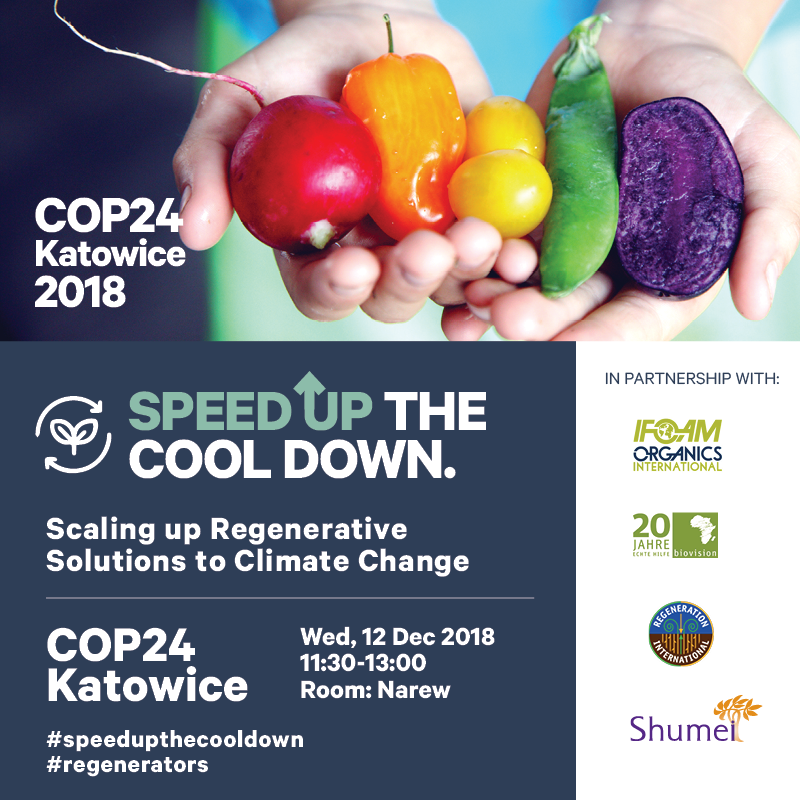 If we want to change the world and reverse climate change, many of us have no choice but to expand our activist horizons and take on the role of entrepreneurs, food and land use systems designers, business planners, project incubators, marketers, and fundraisers. If we don’t presently have these skills—and of course most of us don’t—we need to reach out to friends and supporters who do have these business and financial management skills and get them to help us. Without millions, indeed billions, of dollars invested in scaling up regenerative food and farming enterprises, production and marketing co-ops, and businesses, we will fail. We frankly don’t have time to convert the world to regenerative thinking and practices over the next hundred years, one consumer, one farmer, one retailer at a time. We have to speed up the process, as our Regeneration International banner at COP24 in Poland in 2018 proclaimed: “Speed Up the Cooldown!”
If we want to change the world and reverse climate change, many of us have no choice but to expand our activist horizons and take on the role of entrepreneurs, food and land use systems designers, business planners, project incubators, marketers, and fundraisers. If we don’t presently have these skills—and of course most of us don’t—we need to reach out to friends and supporters who do have these business and financial management skills and get them to help us. Without millions, indeed billions, of dollars invested in scaling up regenerative food and farming enterprises, production and marketing co-ops, and businesses, we will fail. We frankly don’t have time to convert the world to regenerative thinking and practices over the next hundred years, one consumer, one farmer, one retailer at a time. We have to speed up the process, as our Regeneration International banner at COP24 in Poland in 2018 proclaimed: “Speed Up the Cooldown!”
***
So far, in just a few years, the fossil fuel divestment movement has managed to move over $6 trillion in assets out of the coal, petroleum, and nuclear sector, with a significant amount ($300 billion annually) being reinvested into solar, wind, and energy conservation efforts. As this movement continues to gather momentum (and as renewable energy continues to become cheaper and more profitable than dirty coal, oil, and fracking), more and more institutional investors will undoubtedly continue to move their money, eventually forcing even the fossil fuel multinationals themselves to remove stranded assets from their balance sheets and move to renewable forms of energy, or else go bankrupt.
What organizations like 350.org and student, church, and other grassroots climate activists in the divestment movement have done in the energy sector, discrediting degenerative fossil fuel energy corporations and practices and calling for financial divestments, we now need to do in the food, farming, and land use sector. Our strongest arguments are that global industrial food, farming, and land use practices (chemical- and energy-intensive farm inputs and production, processing, packaging, refrigeration, transportation, deforestation, and waste) are generating a full 43 to 57 percent of all current greenhouse gas (GHG) emissions—an amount roughly equal to all the emissions in the nonfood transportation, utilities, building, and manufacturing sectors. These GHG emissions are fueling global warming and ever more severe climate change. In addition, conventional degenerative food, farming, and land use, exemplified by the practices of the Fortune 500 corporations (Bayer/Monsanto, Walmart, McDonald’s, Cargill) that dominate or finance this sector, are destroying our environment, our health, biodiversity, and the livelihoods of the world’s three billion farmers, herders, forest dwellers, fishing communities, and rural villagers.
***
Farmers, ranchers, herders, forest dwellers, and urban agriculturists in every region of the world have already developed organic and agroecological practices (whether certified or not) that are regenerating soils and landscapes. The challenge is to get the funds, trainers, and technical assistance to scale up these best practices, and to do so as quickly as possible.
Maintaining business as usual in terms of investment or foreign aid and development is a recipe for disaster, given the seriousness of our crisis. We need a new wave of regenerative investment to complement public funds, market demand, farmer innovation, and progressive policy change, and we need it now.
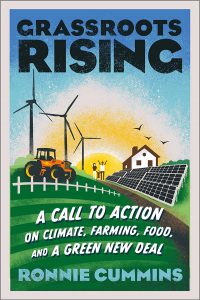 The above excerpt is adapted from Ronnie Cummins’ new book Grassroots Rising: A Call to Action on Climate, Farming, Food, and A Green New Deal (Chelsea Green Publishing, February 2020) and is reprinted with permission from the publisher.
The above excerpt is adapted from Ronnie Cummins’ new book Grassroots Rising: A Call to Action on Climate, Farming, Food, and A Green New Deal (Chelsea Green Publishing, February 2020) and is reprinted with permission from the publisher.
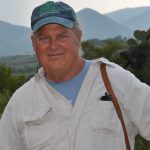
About Ronnie Cummins
Ronnie Cummins is the founder and director of the Organic Consumers Association (OCA), a non-profit, US- based network of more than two million consumers dedicated to safeguarding organic standards and promoting a healthy, just, and regenerative system of food, farming, and commerce. Cummins also serves on the steering committee of Regeneration International and OCA’s Mexican affiliate, Vía Orgánica
True Health | What if the Virus is the Medicine?
True Health | What if the Virus is the Medicine?
The emerging pandemic is already a watershed of the early 21st century: things won’t ever be the same. Yet for all that the havoc that the virus is wreaking, directly and indirectly, it may also be part of the bitter medicine the global body needs.
How could adding another crisis to an already crisis-ridden planet possibly be medicinal?
Before we explore that question, we want to be clear: our intent is not to downplay the severity or minimize the importance of lives lost to this disease. Behind the mortality figures lie very real pain and grief, and these numbers, often discussed so casually, are personal, representing the potential loss of our parents, elders, teachers, dance companions, grandmothers or immune-compromised friends. Already, our hearts are breaking for the physical distance with our aging parents until we know if we’re infected. There’s not only a risk of losing beloveds in this time, but having to do so from afar. Our hearts are breaking for those who may die or suffer alone, without the touch of their loved ones. We honor death as a sacred passage, but we do not minimize death, suffering or sickness in the slightest. We pray that each one who transitions from this virus (as from the many other deadly diseases, accidents, overdoses, murders, suicides, mass shootings, and on and on) be met with on the other side by unexpected blessing, connection, peace.
Neither are the economic implications to be taken lightly. Many in this country have already seen massive impact, and the recession has only begun. As always, those closest to the edge will be hit hardest. For some, a month sequestered in beauty could be a vacation. Others have a few months before financial panic sets in. And for others living paycheck to paycheck or gig to gig, there is a great immediacy of struggle. The economic ‘side effects’ of this coronavirus could be catastrophic.
And yet.
For many in our world, the pre-coronavirus status quo was already catastrophic –indeed, for many species and many peoples, the world has already ended. We are in the midst of a crisis of unprecedented magnitude: the choice for humanity is change or die. No one said change would be easy. (Neither is dying.) And incremental change is not enough. It will take radical change to shift our current, calamitous trajectory away from massive environmental devastation, famine, energy crises, war and refugee crises, increasingly authoritarian regimes and escalating inequalities.
What is unsustainable cannot persist, by definition, and we are starting to see this play out.
What hope is there, then? There is the hope that breakdown will become, or coexist with, breakthrough.
There is the hope that what is dying is the caterpillar of immature humanity in order that the metamorphosis yields a stunning emergence. That whatever survives this collective initiation process will be truer, more heart-connected, resilient and generative.
We are entering the chrysalis. There’s no instruction manual for what happens next. But we can learn some things from observing nature (thank you Megan Toben for some of this biological info). For one thing, the chrysalis stage is preceded by a feeding frenzy in which the caterpillar massively overconsumes (sound familiar? We’ve been there for decades). Then its tissues melt into a virtually undifferentiated goo. What remain separate are so-called imaginal cells, which link together and become the template from which the goo reorganizes itself into a butterfly. Does the caterpillar overconsume strategically, or out of blind instinct? Does it know what’s coming and trust in the process, or does it feel like it’s dying? We don’t know. It’s natural to resist radical, painful change. But ultimately there’s little choice but to surrender to it. We can practice welcoming the circumstances that force us away from dysfunctional old patterns, be they economic or personal. We have that opportunity now.
Let’s return to a crucial word, initiation. On an individual level, initiations are those processes or rituals by which one reaches a new state of being and corresponding social status: from girl to woman, from layperson to clergy, and so on. Initiations can be deliberate or spontaneous, as in the case of the archetypal shamanic initiation, which comes by way of a healing crisis. To paraphrase Michael Meade, initiations are events that pull us deeper into life than we would otherwise go. They vary widely from culture to culture and individual to individual, but two characteristics they share are intensity and transformation. They bring us face to face with life and with death; they always involve an element of dying or shedding so that the new can be born.
Most all of us have undergone initiations of one sort of another, from the death of a parent to the birth of a child. Many have experienced initiation in the form of a crisis or trial by fire. Those of us who have gone through more deliberate, ritualized forms of initiation can state unequivocally: the process is not fun, comfortable or predictable. You may well feel like you’re going nuts. You may not know who you are anymore. You don’t get to choose which parts of you die, or even to know ahead of time. One of the overriding feelings is of uncertainty: you don’t know where you’re going, only that there’s no going back. And there’s no way of knowing how long the transformation will take.
It can help to remember that the initiatory chrysalis phase is a sacred time, set apart from normal life. That it has its own demands and its own logic. That it cannot be rushed, only surrendered to. That it may be painful, but also, ultimately, healing.
Imagine what happens when an entire society finds itself in the midst of a critical initiation. Except you don’t have to imagine: it’s already happening, or starting to. It looks like chaos, a meltdown. We’re in a moment of collective, global-level crisis and uncertainty that has little precedent in living memory. The economic machine–the source of our financial needs and also a system that profits from disease, divorce, crime and tragedy–is faced with a dramatic slow-down. We are all facing the cessation of non-essential activities. There is opportunity here, if we claim it.
This is a sacred time.
However, unlike a traditional rite of passage ceremony, there’s no priest or elder with wisdom born of experience holding the ritual container, tracking everything seen and unseen. Instead, all at once there are millions of personal quests inside one enormous initiatory chrysalis. And yet, look closely: amid the goo, you may start to notice imaginal cells appearing. Pockets of people who are aligned with something they may not fully understand, in receipt of a vision or pieces of one, beaming out their signal to say: let’s try something different.
This is an opportunity to loosen our grip on old and familiar ways. Those ways worked for as long as they did, and they got us here, for better and for worse. They seem unlikely to carry us much further. What if we’re instead being asked to feel our way forward, from the heart, without benefit of certainty–which, when concentrated, quickly becomes toxic? No one has all the answers in this or any other time. Right now the questions may be more valuable.
What if we honor this time with sacred respect?
What if we take the time to listen for the boundaries and limits of our Earth mother?
What is truly important?
How can we receive the bitter medicine of the moment deep into our cells and let it align us with latent possibility?
How can we, with the support of the unseen, serve as midwives to all that is dying here and all that is being born?
With these questions resounding, let us s l o w d o w n and listen. For the echo back from the unseen, for whisperings from the depths of our souls and from the heart of the mystery that–no less so in times of crisis–embraces us all.
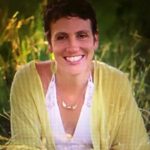
About Julia Hartsell
Julia Hartsell is a dancer, catalyst for soulful, earth-honoring community and founder of The Flowjo, a sanctuary for embodied practice in Carrboro, NC. With a background in performance art and world religions, Julia has spent her adult life seeking the mystical through movement. Trusting the body’s inherent wisdom and sacredness, she utilizes these diverse practices to help access the body’s intuition for emotional expression and transformation. Visit | www.HeartwardSanctuary.org
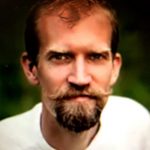
About Jonathan Hadas Edwards
Jonathan Hadas Edwards, MS, MFA, LAc. is an herbalist, diviner, and ritual drummer who comes to Heartward Sanctuary with a background in religious studies, languages & literature and Asian medicine. His search for the roots of our environmental and cultural woes has led him to immersion in wisdom and healing traditions from East and South Asia and West Africa, and he combines mantic arts with plant medicine in his individual healing work. Visit | www.HeartwardSanctuary.org
Coronavirus Spells the End of the Neoliberal Era. What’s Next?
Coronavirus Spells the End of the Neoliberal Era. What’s Next?
Originally published in Patterns of Meaning
Coronavirus is a political crucible, melting down and reshaping current norms. Will the new era be a “Fortress Earth” or a harbinger of a transformed society based on a new set of values?
Think Bigger
Whatever you might be thinking about the long-term impacts of the coronavirus epidemic, you’re probably not thinking big enough.
Our lives have already been reshaped so dramatically in the past few weeks that it’s difficult to see beyond the next news cycle. We’re bracing for the recession we all know is here, wondering how long the lockdown will last, and praying that our loved ones will all make it through alive.
But, in the same way that Covid-19 is spreading at an exponential rate, we also need to think exponentially about its long-term impact on our culture and society. A year or two from now, the virus itself will likely have become a manageable part of our lives—effective treatments will have emerged; a vaccine will be available. But the impact of coronavirus on our global civilization will only just be unfolding. The massive disruptions we’re already seeing in our lives are just the first heralds of a historic transformation in political and societal norms.
If Covid-19 were spreading across a stable and resilient world, its impact could be abrupt but contained. Leaders would consult together; economies disrupted temporarily; people would make do for a while with changed circumstances—and then, after the shock, look forward to getting back to normal. That’s not, however, the world in which we live. Instead, this coronavirus is revealing the structural faults of a system that have been papered over for decades as they’ve been steadily worsening. Gaping economic inequalities, rampant ecological destruction, and pervasive political corruption are all results of unbalanced systems relying on each other to remain precariously poised. Now, as one system destabilizes, expect others to tumble down in tandem in a cascade known by researchers as “synchronous failure.”
The first signs of this structural destabilization are just beginning to show. Our globalized economy relies on just-in-time inventory for hyper-efficient production. As supply chains are disrupted through factory closures and border closings, shortages in household items, medications, and food will begin surfacing, leading to rounds of panic buying that will only exacerbate the situation. The world economy is entering a downturn so steep it could exceed the severity of the Great Depression. The international political system—already on the ropes with Trump’s “America First” xenophobia and the Brexit fiasco—is likely to unravel further, as the global influence of the United States tanks while Chinese power strengthens. Meanwhile, the Global South, where Covid-19 is just beginning to make itself felt, may face disruption on a scale far greater than the more affluent Global North.
The Overton Window
During normal times, out of all the possible ways to organize society, there is only a limited range of ideas considered acceptable for mainstream political discussion—known as the Overton window. Covid-19 has blown the Overton window wide open. In just a few weeks, we’ve seen political and economic ideas seriously discussed that had previously been dismissed as fanciful or utterly unacceptable: universal basic income, government intervention to house the homeless, and state surveillance on individual activity, to name just a few. But remember—this is just the beginning of a process that will expand exponentially in the ensuing months.
A crisis such as the coronavirus pandemic has a way of massively amplifying and accelerating changes that were already underway: shifts that might have taken decades can occur in weeks. Like a crucible, it has the potential to melt down the structures that currently exist, and reshape them, perhaps unrecognizably. What might the new shape of society look like? What will be center stage in the Overton window by the time it begins narrowing again?
The Example of World War II
We’re entering uncharted territory, but to get a feeling for the scale of transformation we need to consider, it helps to look back to the last time the world underwent an equivalent spasm of change: the Second World War.
The pre-war world was dominated by European colonial powers struggling to maintain their empires. Liberal democracy was on the wane, while fascism and communism were ascendant, battling each other for supremacy. The demise of the League of Nations seemed to have proven the impossibility of multinational global cooperation. Prior to Pearl Harbor, the United States maintained an isolationist policy, and in the early years of the war, many people believed it was just a matter of time before Hitler and the Axis powers invaded Britain and took complete control of Europe.
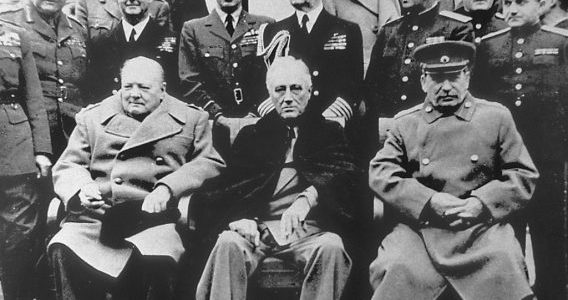
Within a few years, the world was barely recognizable. As the British Empire crumbled, geopolitics was dominated by the Cold War which divided the world into two political blocs under the constant threat of nuclear Armageddon. A social democratic Europe formed an economic union that no-one could previously have imagined possible. Meanwhile, the US and its allies established a system of globalized trade, with institutions such as the IMF and the World Bank setting terms for how the “developing world” could participate. The stage was set for the “Great Acceleration”: far and away the greatest and most rapid increase of human activity in history across a vast number of dimensions, including global population, trade, travel, production, and consumption.
If the changes we’re about to undergo are on a similar scale to these, how might a future historian summarize the “pre-coronavirus” world that is about to disappear?
The Neoliberal Era
There’s a good chance they will call this the Neoliberal Era. Until the 1970s, the post-war world was characterized in the West by an uneasy balance between government and private enterprise. However, following the “oil shock” and stagflation of that period—which at the time represented the world’s biggest post-war disruption—a new ideology of free-market neoliberalism took center stage in the Overton window (the phrase itself was named by a neoliberal proponent).
The value system of neoliberalism, which has since become entrenched in global mainstream discourse, holds that humans are individualistic, selfish, calculating materialists, and because of this, unrestrained free-market capitalism provides the best framework for every kind of human endeavor. Through their control of government, finance, business, and media, neoliberal adherents have succeeded in transforming the world into a globalized market-based system, loosening regulatory controls, weakening social safety nets, reducing taxes, and virtually demolishing the power of organized labor.
The triumph of neoliberalism has led to the greatest inequality in history, where (based on the most recent statistics) the world’s twenty-six richest people own as much wealth as half the entire world’s population. It has allowed the largest transnational corporations to establish a stranglehold over other forms of organization, with the result that, of the world’s hundred largest economies, sixty-nine are corporations. The relentless pursuit of profit and economic growth above all else has propelled human civilization onto a terrifying trajectory. The uncontrolled climate crisis is the most obvious danger: The world’s current policies have us on track for more than 3° increase by the end of this century, and climate scientists publish dire warnings that amplifying feedbacks could make things far worse than even these projections, and thus place at risk the very continuation of our civilization.
But even if the climate crisis were somehow brought under control, a continuation of untrammeled economic growth in future decades will bring us face-to-face with a slew of further existential threats. Currently, our civilization is running at 40% above its sustainable capacity. We’re rapidly depleting the earth’s forests, animals, insects, fish, freshwater, even the topsoil we require to grow our crops. We’ve already transgressed three of the nine planetary boundaries that define humanity’s safe operating space, and yet global GDP is expected to more than double by mid-century, with potentially irreversible and devastating consequences.
In 2017 over fifteen thousand scientists from 184 countries issued an ominous warning to humanity that time is running out: “Soon it will be too late,” they wrote, “to shift course away from our failing trajectory.” They are echoed by the government-approved declaration of the UN-sponsored IPCC, that we need “rapid, far-reaching and unprecedented changes in all aspects of society” to avoid disaster.
In the clamor for economic growth, however, these warnings have so far gone unheeded. Will the impact of coronavirus change anything?
Fortress Earth
There’s a serious risk that, rather than shifting course from our failing trajectory, the post-Covid-19 world will be one where the same forces currently driving our race to the precipice further entrench their power and floor the accelerator directly toward global catastrophe. China has relaxed its environmental laws to boost production as it tries to recover from its initial coronavirus outbreak, and the US (anachronistically named) Environmental Protection Agency took immediate advantage of the crisis to suspend enforcement of its laws, allowing companies to pollute as much as they want as long as they can show some relation to the pandemic.
On a greater scale, power-hungry leaders around the world are taking immediate advantage of the crisis to clamp down on individual liberties and move their countries swiftly toward authoritarianism. Hungary’s strongman leader, Viktor Orban, officially killed off democracy in his country on Monday, passing a bill that allows him to rule by decree, with five-year prison sentences for those he determines are spreading “false” information. Israel’s Prime Minister Netanyahu shut down his country’s courts in time to avoid his own trial for corruption. In the United States, the Department of Justice has already filed a request to allow the suspension of courtroom proceedings in emergencies, and there are many who fear that Trump will take advantage of the turmoil to install martial law and try to compromise November’s election.
Even in those countries that avoid an authoritarian takeover, the increase in high-tech surveillance taking place around the world is rapidly undermining previously sacrosanct privacy rights. Israel has passed an emergency decree to follow the lead of China, Taiwan, and South Korea in using smartphone location readings to trace contacts of individuals who tested positive for coronavirus. European mobile operators are sharing user data (so far anonymized) with government agencies. As Yuval Harari has pointed out, in the post-Covid world, these short-term emergency measures may “become a fixture of life.”
If these, and other emerging trends, continue unchecked, we could head rapidly to a grim scenario of what might be called “Fortress Earth,” with entrenched power blocs eliminating many of the freedoms and rights that have formed the bedrock of the post-war world. We could be seeing all-powerful states overseeing economies dominated even more thoroughly by the few corporate giants (think Amazon, Facebook) that can monetize the crisis for further shareholder gain.
The chasm between the haves and have-nots may become even more egregious, especially if treatments for the virus become available but are priced out of reach for some people. Countries in the Global South, already facing the prospect of disaster from climate breakdown, may face collapse if coronavirus rampages through their populations while a global depression starves them of funds to maintain even minimal infrastructures. Borders may become militarized zones, shutting off the free flow of passage. Mistrust and fear, which has already shown its ugly face in panicked evictions of doctors in India and record gun-buying in the US, could become endemic.
Society Transformed
But it doesn’t have to turn out that way. Back in the early days of World War II, things looked even darker, but underlying dynamics emerged that fundamentally altered the trajectory of history. Frequently, it was the very bleakness of the disasters that catalyzed positive forces to emerge in reaction and predominate. The Japanese attack on Pearl Harbor—the day “which will live in infamy”—was the moment when the power balance of World War II shifted. The collective anguish in response to the global war’s devastation led to the founding of the United Nations. The grotesque atrocity of Hitler’s holocaust led to the international recognition of the crime of genocide, and the UN’s Universal Declaration of Human Rights.
Could it be that the crucible of coronavirus will lead to a meltdown of neoliberal norms that ultimately reshapes the dominant structures of our global civilization? Could a mass collective reaction to the excesses of authoritarian overreach lead to a renaissance of humanitarian values? We’re already seeing signs of this. While the Overton window is allowing surveillance and authoritarian practices to enter from one side, it’s also opening up to new political realities and possibilities on the other side. Let’s take a look at some of these.
A fairer society. The specter of massive layoffs and unemployment has already led to levels of state intervention to protect citizens and businesses that were previously unthinkable. Denmark plans to pay 75% of the salaries of employees in private companies hit by the effects of the epidemic, to keep them and their businesses solvent. The UK has announced a similar plan to cover 80% of salaries. California is leasing hotels to shelter homeless people who would otherwise remain on the streets, and has authorized local governments to halt evictions for renters and homeowners. New York state is releasing low-risk prisoners from its jails. Spain is nationalizing its private hospitals. The Green New Deal, which was already endorsed by the leading Democratic presidential candidates, is now being discussed as the mainstay of a program of economic recovery. The idea of universal basic income for every American, boldly raised by long-shot Democratic candidate Andrew Yang, has now become a talking point even for Republican politicians.
Ecological stabilization. Coronavirus has already been more effective in slowing down climate breakdown and ecological collapse than all the world’s policy initiatives combined. In February, Chinese CO2 emissions were down by over 25%. One scientist calculated that twenty times as many Chinese lives have been saved by reduced air pollution than lost directly to coronavirus. Over the next year, we’re likely to see a reduction in greenhouse gas emissions greater than even the most optimistic modelers’ forecasts, as a result of the decline in economic activity. As French philosopher Bruno Latour tweeted: “Next time, when ecologists are ridiculed because ‘the economy cannot be slowed down’, they should remember that it can grind to a halt in a matter of weeks worldwide when it is urgent enough.”
Of course, nobody would propose that economic activity should be disrupted in this catastrophic way in response to the climate crisis. However, the emergency response initiated so rapidly by governments across the world has shown what is truly possible when people face what they recognize as a crisis. As a result of climate activism, 1,500 municipalities worldwide, representing over 10% of the global population, have officially declared a climate emergency. The Covid-19 response can now be held out as an icon of what is really possible when people’s lives are at stake. In the case of the climate, the stakes are even greater—the future survival of our civilization. We now know the world can respond as needed, once political will is engaged and societies enter emergency mode
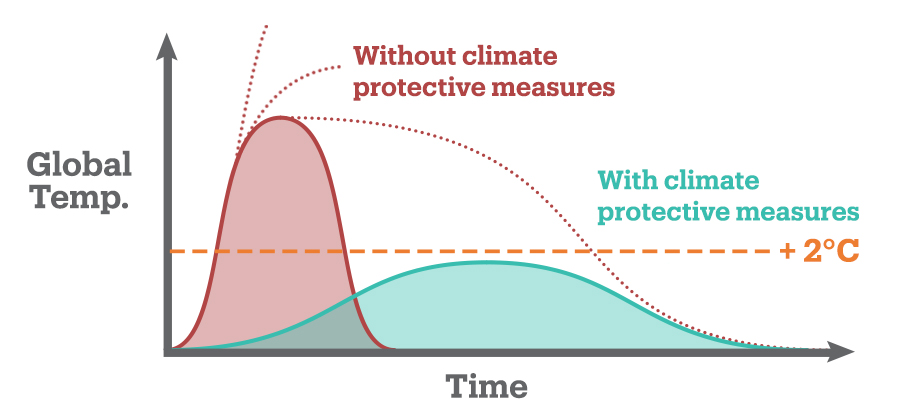
The rise of “glocalization.” One of the defining characteristics of the Neoliberal Era has been a corrosive globalization based on free market norms. Transnational corporations have dictated terms to countries in choosing where to locate their operations, leading nations to compete against each other to reduce worker protections in a “race to the bottom.” The use of cheap fossil fuels has caused wasteful misuse of resources as products are flown around the world to meet consumer demand stoked by manipulative advertising. This globalization of markets has been a major cause of the Neoliberal Era’s massive increase in consumption that threatens civilization’s future. Meanwhile, masses of people disaffected by rising inequity have been persuaded by right-wing populists to turn their frustration toward outgroups such as immigrants or ethnic minorities.
The effects of Covid-19 could lead to an inversion of these neoliberal norms. As supply lines break down, communities will look to local and regional producers for their daily needs. When a consumer appliance breaks, people will try to get it repaired rather than buy a new one. Workers, newly unemployed, may turn increasingly to local jobs in smaller companies that serve their community directly.
At the same time, people will increasingly get used to connecting with others through video meetings over the internet, where someone on the other side of the world feels as close as someone across town. This could be a defining characteristic of the new era. Even while production goes local, we may see a dramatic increase in the globalization of new ideas and ways of thinking—a phenomenon known as “glocalization.” Already, scientists are collaborating around the world in an unprecedented collective effort to find a vaccine; and a globally crowdsourced library is offering a “Coronavirus Tech Handbook” to collect and distribute the best ideas for responding to the pandemic.
Compassionate community. Rebecca Solnit’s 2009 book, A Paradise Built in Hell, documents how, contrary to popular belief, disasters frequently bring out the best in people, as they reach out and help those in need around them. In the wake of Covid-19, the whole world is reeling from a disaster that affects us all. The compassionate response Solnit observed in disaster zones has now spread across the planet with a speed matching the virus itself. Mutual aid groups are forming in communities everywhere to help those in need. The website Karunavirus (Karuna is a Sanskrit word for compassion) documents a myriad of everyday acts of heroism, such as the thirty thousand Canadians who have started “caremongering,” and the mom-and-pop restaurants in Detroit forced to close and now cooking meals for the homeless.
In the face of disaster, many people are rediscovering that they are far stronger as a community than as isolated individuals. The phrase “social distancing” is helpfully being recast as “physical distancing” since Covid-19 is bringing people closer together in solidarity than ever before.
Revolution in Values
This rediscovery of the value of community has the potential to be the most important factor of all in shaping the trajectory of the next era. New ideas and political possibilities are critically important, but ultimately an era is defined by its underlying values, on which everything else is built.
The Neoliberal Era was constructed on a myth of the selfish individual as the foundational for values. As Margaret Thatcher famously declared, “There’s no such thing as society. There are individual men and women and there are families.” This belief in the selfish individual has not just been destructive of community—it’s plain wrong. In fact, from an evolutionary perspective, a defining characteristic of humanity is our set of prosocial impulses—fairness, altruism, and compassion—that cause us to identify with something larger than our own individual needs. The compassionate responses that have arisen in the wake of the pandemic are heartwarming but not surprising—they are the expected, natural human response to others in need.
Once the crucible of coronavirus begins to cool, and a new sociopolitical order emerges, the larger emergency of climate breakdown and ecological collapse will still be looming over us. The Neoliberal Era has set civilization’s course directly toward a precipice. If we are truly to “shift course away from our failing trajectory,” the new era must be defined, at its deepest level, not merely by the political or economic choices being made, but by a revolution in values. It must be an era where the core human values of fairness, mutual aid, and compassion are paramount—extending beyond the local neighborhood to state and national government, to the global community of humans, and ultimately to the community of all life. If we can change the basis of our global civilization from one that is wealth-affirming to one that is life-affirming, then we have a chance to create a flourishing future for humanity and the living Earth.
To this extent, the Covid-19 disaster represents an opportunity for the human race—one in which each one of us has a meaningful part to play. We are all inside the crucible right now, and the choices we make over the weeks and months to come will, collectively, determine the shape and defining characteristics of the next era. However big we’re thinking about the future effects of this pandemic, we can think bigger. As has been said in other settings, but never more to the point: “A crisis is a terrible thing to waste.”
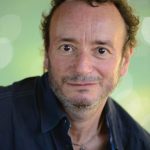
About Jeremy Lent
Jeremy Lent is author of The Patterning Instinct: A Cultural History of Humanity’s Search for Meaning, which investigates how different cultures have made sense of the universe and how their underlying values have changed the course of history. His new book, The Web of Meaning: Integrating Science and Traditional Wisdom to Find Our Place in the Universe, was published in Spring 2021 (New Society Press: North America | Profile Books: UK & Commonwealth). For more information visit jeremylent.com.
The Evolutionary Potential of Wealth
The Evolutionary Potential of Wealth
True Wealth | What Matters Most?
We have crossed a threshold, and life just a few months ago feels like the distant past. What matters most now?
When we started working on this edition, fires were raging in Australia, new alarms were being raised by indigenous leaders to protect our waters from dangerous fracking and pipelines, and ‘regenerative agriculture’ was finally gaining some currency in the mainstream. Surely, we decided, our forests and animals, clean water, and rich soil are all true wealth!
And now…wellness. Our health and the wellbeing of our loved ones has suddenly come into laser focus, the freedom to simply take a deep clear breath. Take one now and send loving gratitude to your lungs, your body. Yes, it is true wealth just to breathe. The ability to breathe unites us all.
So, where is ‘money’ in all of this? Is money wealth? We know that the race to accumulate monetary wealth has played a historically destructive role extracting, commodifying and exploiting Nature’s abundance and living beings. And, as the dual forces of the stock market – greed and fear – play a tug-of-war with the economy, millions are losing their small savings, needed retirement funds, future dreams. For those with no savings at all, not having enough money to provide for hungry families is a very deep form of suffering.
So, I’m hesitant to uplift other forms of ‘capital’ right now – intellectual, spiritual, relational…or to speak of the pandemic as a unifying force for good. I’m reminded instead of a gatha one of my teachers recently shared. ‘Breathing in, my mind is clear; breathing out, I don’t know.’ We don’t know where things are heading, whether the virus will unify or divide. Mental clarity though, is more precious than gold – awareness of the body, of the breath, appreciation for the sky and the trees, helpfulness toward our neighbors, compassion for our communities.
Still, I find myself wondering, what is the evolutionary purpose of material wealth? What role could and should money play at this time?
We may think that economic disparity is the inevitable result of human economic activity. I’m not an economist, but what I understand from the study of cultures is that for about 99% of our time on Earth, it wasn’t the case. Only with the rise of agriculture and sedentism, living in one place for a long time, did ‘surplus’ emerge. Prior to that, and even to this day, humans bartered. But barter was never necessarily a direct trade, ‘this for that’. Instead, in most pre-agricultural communities, complex systems of reciprocal exchange, based on kinship, communal memory, and trust were the norm. I might give you a basket of fruit today, and you will recall that my cousin helped you build your home last season – and so when my mother becomes ill next winter, you will send your daughter with healing medicines to help care for her. These agreements were mostly unspoken and mediated by the entire community.
Today however, greed is the norm. It is easy to vilify the ‘one percent’, to blame ‘them’ for the entire mess of greedy modernism. But, looking deeper, we can acknowledge that the seed of greed lives in each of us and is baked in the cake of the consumerist mindset. And to be fair, wealth and generosity can go hand-in-hand.
Again I tell you, it is easier for a camel to go through the eye of a needle than for a rich person to enter the kingdom of God. – Matthew 19:24
What do we make of ‘the wealthy’? Some people say Matthew’s pronouncement about the “eye of the needle” may have referred to a literal small gate in the old city of Jerusalem that a camel could pass through only once it shed the belongings strapped to its sides. True or not, we have all heard the phrase, ‘you can’t take it with you’. Then why do we live in a world where the richest 1% own half the world’s money? Could this extraordinary disparity have an evolutionary purpose?
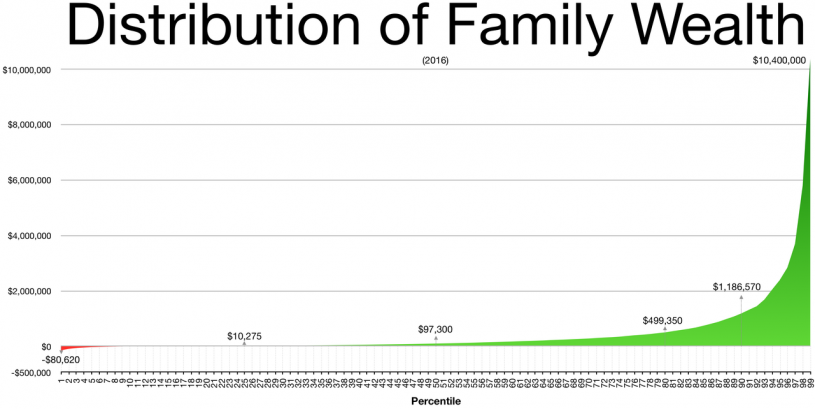
Let’s consider the argument that many of modernity’s increasingly complex problems will require vast sums of concentrated wealth to ‘fix’, or at least address. New viruses need new vaccines. Worldwide carbon sequestration, forest conservation, soil regeneration, wildlife protection, water purification, and global education all require investment and charitable giving on massive scales. That ‘spike’ on the right-hand side of the wealth chart? Could it be the evolutionary sword that helps us break through to the next planetary era? Wicked wealth to solve wicked problems?
Brian Swimme reminds us that all accumulated wealth is comprised of surplus photons from the Sun. If we are looking for a model of supreme cosmological generosity, we can find it at the center of our solar system, he says. The Sun sacrifices more than 4 billion tons of its body into energy every second, radiating freely in all directions, with no discrimination. Swimme likens this to the evolutionary urge in the human heart to give freely to others – our time, attention, and care – to our children and loved ones, our communities, and beings in distress.
Right now, the greatest generational wealth transfer in human history is underway. Over the next 25 years, 45 million U.S. households will pass a mind-boggling $68 trillion to their children. Can Swimme’s cosmological model point young inheritors toward a new vision for giving during this pivotal evolutionary moment? To learn more I convened with millennials at Family Office and Family Foundation events, and at the NEXUS USA Summit in Washington, D.C. NEXUS serves ‘the next generation of influential families around the world”.
What I learned was encouraging, and even inspiring. There is a growing cohort of young inheritors of great wealth who are waking up to the evolutionary potential of their money.
This cohort wants to do the right thing, but just like us, they need help overcoming their fear, and in some cases, shame about money and the historic trauma attached to it. They need to unravel complex family dynamics and archaic family investments. They need wise guidance and initiation experiences to help them understand the unique role they can play when they align their values with highest Purpose. Let us not disparage their aspiration. We need them, and they need us. Much good can, and has been done by philanthropy and social-impact investment when it is driven by compassion and fairness. Innovation, guided by spirit, transforms.
Sixty thousand years ago, a cascading series of events diminished the entire human population to about ten thousand freezing, scared, resilient members of Homo sapiens. These are our common grandmothers and grandfathers, the evolutionary portal through which each of us has passed. This is our tribe. The human family may be greatly diminished some day again, if not by this pandemic then by some other series of events. Or maybe this is the beginning of the great unraveling. ‘Sole’ survival should not be our focus. ‘Soul’ survival should.
Whatever happens, we have the capacity right now to breathe, to regard the sky in awe, to still hear birdsong, to smile to a child, and embrace a loved one. Let us unite our hearts and bring forward the best ideas, the best blueprints, the best stories and songs, humanity’s best efforts for those generations yet to come. Let us model the planetary era we wish to usher in, giving, receiving, sharing freely. We need everyone’s gifts, and we need to be able to offer our own, in all directions, like the Sun.
Please look to the wisdom of the writers and artists in this edition to inspire and guide you. Kosmos is a refuge and a wellspring of hope in troubled times. A new world and a new human is evolving, and you can track and participate in this unfolding through Kosmos.
May all beings be well.
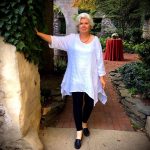
About Rhonda Fabian
Rhonda Fabian is Editor of Kosmos Quarterly. She is an ordained member in the Order of Interbeing, an international Buddhist community founded by her teacher, Thích Nhất Hạnh. Rhonda is also a founding partner of Immediacy Learning, an educational media company that has impacted millions of learners worldwide.
Ordinary Grace
Fear came knocking, faith opened the door, but no one was there.
—Chinese proverb
I recall a Haida elder taking me on a short hike inland from the eastern coast of Vancouver Island to see the end of the swimmer, his name for salmon. It was a magical place. We followed a stream in which the salmon were so thick that I’m sure I could walk across the stream on their backs and not get my boots wet. In a quiet green pool, female salmon were laying their eggs, waiting for the males to cover them with milt. Eagles were perched in every cedar, fir, and spruce surrounding the pool. We hiked back to the coast and sat on the rocks at the edge of a stony beach where orcas come close into shore to rub themselves along the smooth pebbled bottom. The elder spoke to me of the swimmer. “Fred, you understand that the swimmer dies after spending himself completely for the end for which he is made.” Then he looked at me and, without speaking, asked me, “Can you be like the swimmer and spend your life completely for the end for which you are created?”
His question is not a vague abstract attitude toward humanity in general but points to a single meeting in which the miracle of life is shared. I recalled Jesus’ teaching, ”Love the Lord your God with all your heart and with all your soul and with all your mind” (Mathew 22:37). And words by Rabi’a al-Adawiyya, an eighth-century Islamic saint,
“How can you describe the true form of something
In whose presence you are blotted out?
And in whose being you still exist?”
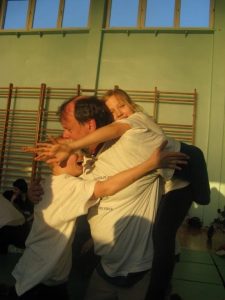 The elder reminded me of Paul. Paul was in my kindergarten class. He had leukemia. His doctors and parents were afraid that rambunctious play would hasten his death. So, for six months I included Paul in our play in a variety of ways so that he didn’t get tired. For example, when we went outside to play, I carried him around the playground on my shoulders or he rode on my back when I was a horse.
The elder reminded me of Paul. Paul was in my kindergarten class. He had leukemia. His doctors and parents were afraid that rambunctious play would hasten his death. So, for six months I included Paul in our play in a variety of ways so that he didn’t get tired. For example, when we went outside to play, I carried him around the playground on my shoulders or he rode on my back when I was a horse.
One day about six months into the school year, Paul came to me and asked me to invite his parents to school for a meeting. The four of us met the following afternoon. Paul was in charge of the meeting. He spoke calmly and clearly. “I want to play with Fred. I know that I’m not going to live as long as the three of you. But I want to live my life as if I were.” There were three crying adults in the room with a four-year-old “therapist.” Paul went to each of us and sat in our laps hugging us. Paul knew what he was asking. I don’t know how we did it, because we never talked, but we agreed that Paul could come and play.
When he came to school the following day, it was like letting a tornado into the classroom. He was very excited and his play was exuberant, passionate, and joyful. He was exhausted by the end of the morning. He stayed home and rested the next day. Because he played so hard when he came to school, Paul could come only every other day. About a month later, Paul died of leukemia. At the funeral, his parents and I asked each other if we had done the right thing by letting him play. We agreed that it was the right thing to do. That night I thought about what Paul taught me. Paul’s trust was not in me, himself, or mom and dad; it was how he lived. Some would say that he trusted in God; Paul never used the word. Paul knew what he was doing. He chose to play and die rather than live and not play.
Such moments stand out now like lighthouses on some far distant shores guiding me gracefully into unknown encounters that cannot be found by seeking. Playing with Paul I felt the joy and sadness, the richness and spontaneity, and the tragic poignancy of childhood. A childhood that each year, bit by bit, slips away beyond memory and is gone. Paul invited me to join him. The simple, overwhelming truth is that exploring the unknowns in a child’s play becomes an exploration of an immense unknown within myself.
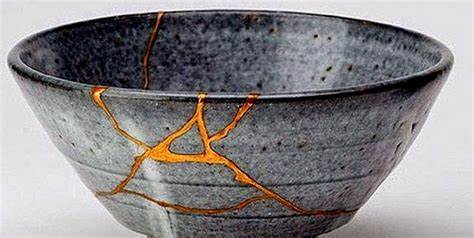
Paul was a fault line in my life. Nothing in my life was the same after playing with Paul. I had been living on the far side of a broken connection with self, other, and God. I was broken and Paul helped fix me. Aljebr in Arabic means “reuniting broken parts.” A similar idea is expressed in the Kabbalistic ideal of tikkun olam, “repairing the world.” In Japanese the word kintsukuroi means “golden repair.” The idea central to these phrases is a process of repairing what has been broken. In Japanese pottery, every crack is part of the history of the object, and it becomes more beautiful precisely because it has been broken. These cracks are repaired with gold. Love is creation’s repair process in which our flaws are repaired with love instead of gold.
I have often thought about Paul and how he taught me to love fully, right now. His choice is an act of trust in life, which is given in trust. I have come to understand that when a heart is humble enough to live without fear, it is the first faint stirrings of life’s beauty seeking flesh and blood expression. Paul’s courage demonstrates that trusting in love is not merely a nice idea nor an ideal, but a no-nonsense way of living one’s ordinary life. Paul was a swimmer.

About O. Fred Donaldson
O. Fred Donaldson is a play specialist, internationally recognized for his ongoing research and use of play with children and animals for over forty years. He has coined the term “original play” to describe his work. He has written the books Playing By Heart: The Vision and Practice of Belonging and Playing For Real: Replaying The Game of Life as well as many articles and book chapters describing his play with children and animals around the world.
The Vitality of Paradox
The Vitality of Paradox
I started and quit French class when I was in eighth grade. I was confident that the word oui should be pronounced “oy”, but my teacher insisted on “we”—a sound that doesn’t look a thing like the spelling. What a ridiculous language, I thought, and she wasn’t inclined to see or hear things my way. After two weeks, I’d had enough, la fin, and signed up for art.
As an adolescent, I perceived rules and creativity as paradox. Now silver-haired, I understand rules and creativity as fundamental life forces, opposing yet complementary principles and energies. Rules and creativity are in constant dialogue in nature and human nature.
The bank says to the river: “You must stop here!”
The river replies to the bank: “I recognize your intent to protect, it is a worthy intent, but notice that if I meander over here and you surrender just a bit, the frogs will have a pool in which to thrive and they will eat the little buzzing mosquitos and, in the warm months, people will come to play. They will sit, legs dangling—trusting your firm and sturdy edge—look down and praise this place that is us.”
As physical construct and metaphor, the maze and the labyrinth occupy this vital paradox. We typically learn of the maze as children, maybe at an amusement park or in a puzzle book meant to keep us entertained—quieted to parental ears—during long road trips. Mazes are complex. Getting from one place to another requires choices, changes in direction, sometimes a retracing of steps when a route comes to an abrupt end. By contrast, labyrinths are unicursal, they are designed to convey a single path that inevitably leads to the center. Intent and an aversion to edge is all that is needed for labyrinth navigation. As a general rule, labyrinths tend to be far less common landscape features than mazes and to walk one alone is often regarded as a spiritual act, a contemplative practice, not something to distract or amuse.
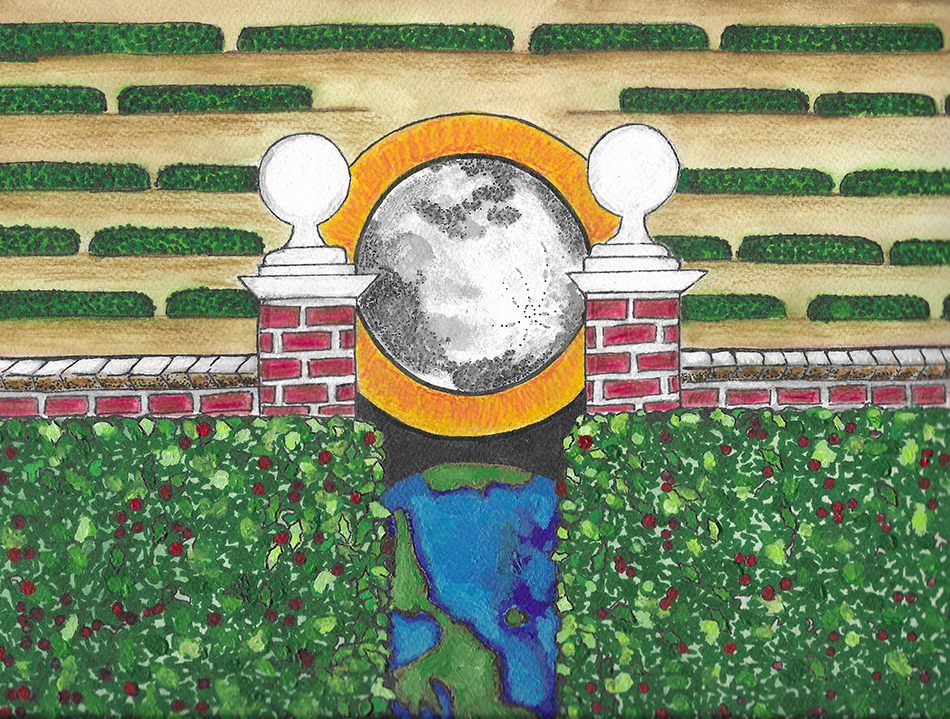
One Friday night while in college I joined a group of beer-groping friends in body-launching over the tall brick wall that surrounds the Governor’s Palace in the heart of Colonial Williamsburg. This was tradition. Every William and Mary student knows it, and every Palace security guard knows it too. The student’s goal: to make one’s way in the dark through the reportedly-haunted holly bush maze without getting caught. The guard’s goal: to flush the students out, to catch them, to avoid being tricked by ghosts, again. This is a rite of passage. This is initiation.
One cannot become initiated into an authentic adulthood without testing and breaking the rules, without violating the prevailing cultural norms. This requires an exploration of the extremes and there isn’t just one way to accomplish the task. Although the undertaking may be collective—a group coming of age—each journey is profoundly and obligatorily unique. It is a solo embarkation. Yet, at the journey’s end, there are stories told that reflect both the individual nuances of paths taken and turned away from, as well as the commonality of the conclusion—something distinctive discovered at the center, at the core of one’s being. Only when integrated do life’s metaphoric mazes and labyrinths become the inter-locking pathways necessary for expanding human consciousness.
Empirical research suggests that individuals who are rebellious by nature—less restrained by a perception of oversight authority—are more likely to serve as cultural creatives. Laboratory experiments have confirmed that people primed with rule-breaking stimuli are more prone to creative ideas. The key to a highly productive business might thus be to give the rebel a cause which has well-defined parameters. A business may be able reach its greatest potential by fostering an atmosphere of contemplative risk-taking; establishing that the rule is to break the rules, that chaos is to be nurtured as long as it is well-planned chaos.
And what of society? What of these times—this age? Do we self-isolate and play by the rules: masks, gloves, a distance of six feet between us? Do we flock to the beach in the season’s hottest bikini? Do we take to the courthouse steps, sword and pistol—or semi-automatic machine gun—at our side?
Do we walk the maze or the labyrinth?
And, the river replied: “Yes!”
Homo sapiens isn’t intended to remain on a pathologically adolescent course—one characterized by an addiction to distraction and entertainment. Nor are we intended to become so disassociated from individual empowerment that we aimlessly surrender to a rule structure imposed by a legally-entitled person, nation state, or framework for world order. The extremes of species expression have brought dis-ease upon us. All of us.
The ego says: “I want this to end as quickly and painlessly as possible.”
The soul says: “I want the experience of walking the labyrinthian maze.”
This is a rite of passage. This is initiation.
This is our opportunity to find a common language—one that may look different but, in essence, sounds the same. From my current vantage point, I can’t describe the lay of the land or how we will occupy it from one moment to the next, or for how long. I can anticipate ghosts. I can expect that there will be mistakes made along the way and that we will have an opportunity to learn from them. I can have faith in the nature of imagination and a rule of nature: that the living thrive when in service of something greater than self.
If we do make our way through, I can bank on there being stories told that reflect both the individual nuances of paths taken and turned away from, as well as the commonality of a new discovery—something of the core nature of the human being, our humanity.
And, so, whatever compels us, we must take the next step.
Oui?
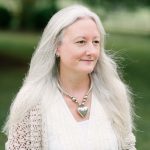
About Jamie K. Reaser, PhD
Jamie K. Reaser, PhD, is a scientist, philosopher, award-winning writer, artist, and regenerative farmer. In all forms, her work explores the inter-relatedness of Nature and human nature and arises from the question, “How do we love ourselves back into the world to the depth and extent that we recognize ourselves as a part of rather than apart from Nature?” She is tended by the meandering Rockfish River and steadfast Blue Ridge Mountains of central Virginia. Her literary website is: jamiekreaser.com.
Becoming Medicine
Becoming Medicine
We are living in disruptive times, yet there have been other times as equally disruptive. People lived through pandemics, plagues, pestilence, famines, natural disasters, slavery, genocide, oppression, and wars upon wars. How did they do it? I believe there is a secret well of resilience and wisdom within the human being—located in the heart—where we find our medicine.
The name for the current pandemic, the coronavirus, comes from the Latin word corona, meaning “crown” or garland bestowed for distinguished military service.” It derives from the ancient Proto-Indo-European (PIE) root sker, meaning “to turn, bend.” PIE is a common ancestral proto-language, hidden beneath the surface of most modern languages.
I have been working with Joseph Rael (Beautiful Painted Arrow) since 2014. He often speaks of the mother tongue. Joseph is a member of the Southern Ute people and grew up at Picuris Pueblo, speaking English, Spanish, and Tiwa. As a mystic, he looks for underlying unity and likes to read up on science. Since our DNA traces back to Africa, Joseph says, “We all come from there; we are all one.” He also says, “Some people call me a medicine man. I don’t know about that—I just work here.”
Joseph is always telling me that we are all connected. “What comes around, goes around,” he says, explaining how the medicine wheel works. Sometimes listening to him gets my own head spinning in circles, but that is how it is when you are initiated into new ways of thinking and new ways of being. Initiation requires entering into disorientation, letting go of who you thought you were so that you can become the medicine you are meant to be.
Joseph Campbell describes the Hero’s Journey as a wheel too: there is a call to adventure, you enter the disorienting unknown, and, after many trials, you discover a healing medicine which you bring back to society, but society rejects you because they are still coming from the old paradigm. Persisting, you help society re-orient to a new world. The personal and the collective are interconnected. This is one of the teachings of the virus.
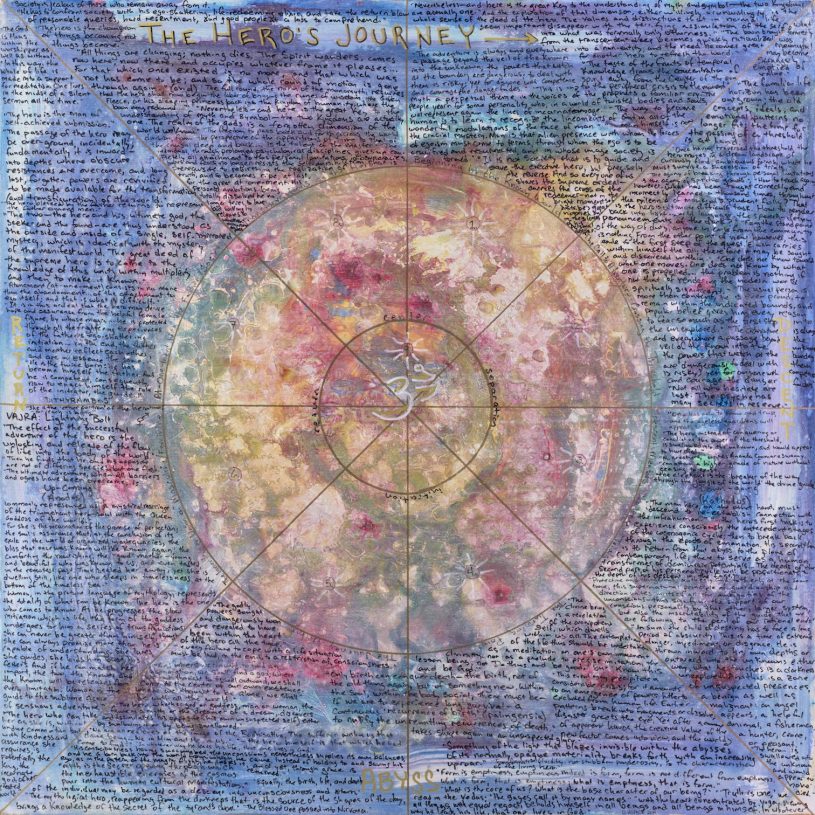
By 1969, the word “coronavirus” was in use, so-called for the crown-like spikes that protrude from the virus membrane, like a corona. The Sun has a corona. NASA describes it as “the outermost part of the Sun’s atmosphere … usually hidden by the bright light of the Sun’s surface.” The corona is something that is there, but difficult to see, or can only be seen at unusual times, like during a total solar eclipse. Paradoxically, there are some things we can only see when the light is obscured.
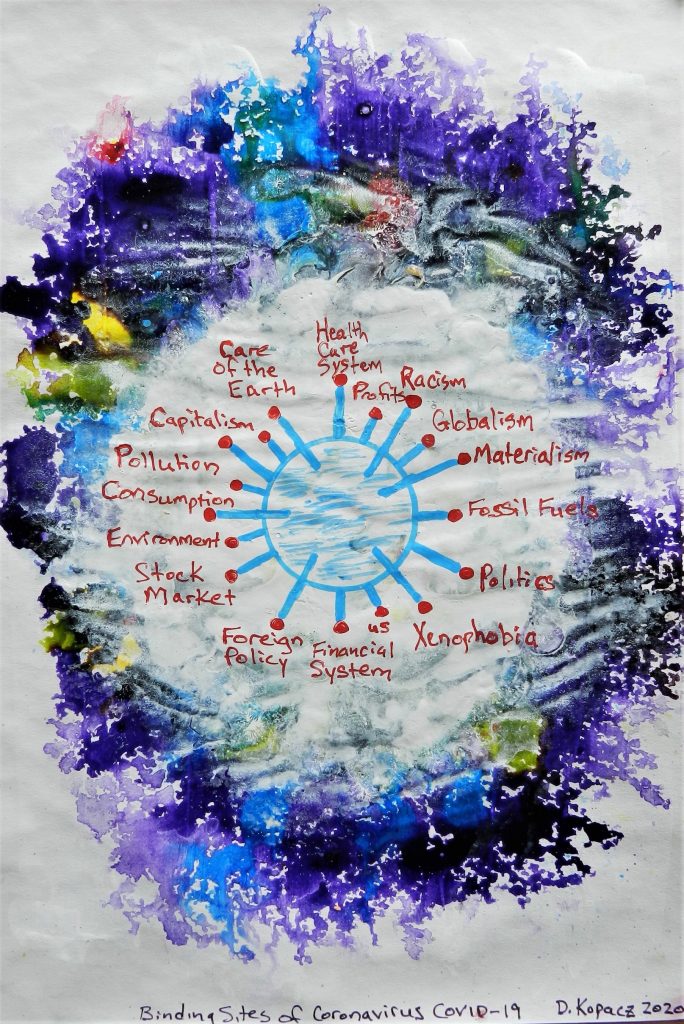 “COVID-19” sounds like a king of some ancient dynastic lineage, wreaking havoc. COVID-19 has a crown of receptors around its central circle. You have probably seen the image; people even say it is beautiful. COVID-19 binds to human cells throughout the body. Yet, we can think of this virus having many external binding sites too: the healthcare system, the financial system, materialism, capitalism, fossil fuels, the stock market, racism, xenophobia, politics, globalism. Everything it touches, it reveals the cracks. The virus shows us that many of the systems we thought were strong (maybe even “great”), such as our economy and the US healthcare system, were actually quite vulnerable.
“COVID-19” sounds like a king of some ancient dynastic lineage, wreaking havoc. COVID-19 has a crown of receptors around its central circle. You have probably seen the image; people even say it is beautiful. COVID-19 binds to human cells throughout the body. Yet, we can think of this virus having many external binding sites too: the healthcare system, the financial system, materialism, capitalism, fossil fuels, the stock market, racism, xenophobia, politics, globalism. Everything it touches, it reveals the cracks. The virus shows us that many of the systems we thought were strong (maybe even “great”), such as our economy and the US healthcare system, were actually quite vulnerable.
We are at war with the pandemic, but is the virus our real enemy?
The virus is of the natural world, maybe originating in bats—nocturnal mammals who do not have great vision, but “see” things in the dark through echolocation. Maybe COVID-19 is teaching us to see things we normally do not see. Maybe it is teaching us to sker—to turn or bend. Maybe it is teaching us to live like we are in a monastery, with reverence, and see that the Earth is a beautiful and fragile place we need to care for and respect. Maybe the virus is only the messenger. In the Spring 2020 issue of Kosmos, Hartsell and Edwards ask, “What if the Virus is the Medicine?” What if the virus is here to cure us?
Of course, there currently is no cure for COVID-19. When there is no cure, what kind of medicine can you use?
Joseph Rael (Beautiful Painted Arrow) and I have been working on the idea of becoming medicine. Becoming medicine is an initiation of transformation that begins with seeking, then finding/receiving, and lastly giving to others the medicine one has become. Joseph tells me:
“In English, medicine is something that still needs to happen, but in Tiwa medicine is already there; it is a power. Every human being is a power. Originally, when we were brought into being, we were given the instructions. Part of life is that we would be given surprises along the way. It just comes upon you and you can’t prepare for it. …Wah-Mah-Chi, that is God’s name in the Tiwa language and it means Breath-Matter-Movement. All you need to know about the virus is to connect those three things, Breath-Matter-Movement, with your heart and lungs.”
The human heart is our medicine bag. The heart is an empty muscular sack with four chambers that we fill with depleted, deoxygenated blood and which the heart and lungs replenish and rejuvenate into rich, oxygenated blood. The heart willingly accepts the worst blood and the best blood. It does not keep the good oxygenated blood medicine to itself but gives it away to the body. The heart’s wisdom is that we are all connected and that to hoard (money, masks, or toilet paper) is to take away from someone else who is just another part of yourself.
In order to know who we are, we need to let go of who we were, of what we thought was important—to embrace transformation and start a movement for living in balance. Here is what Joseph told me about our life with the virus:
“We are at the right place, being in this pandemic. It may seem like we chose it—that’s why we’re here. I have to be here to balance the other side of the planet. We are very much an integral part of all the other families that exist on the Earth and we have to do the best to be ourselves. We have to do what we can, and help how and when we can.”
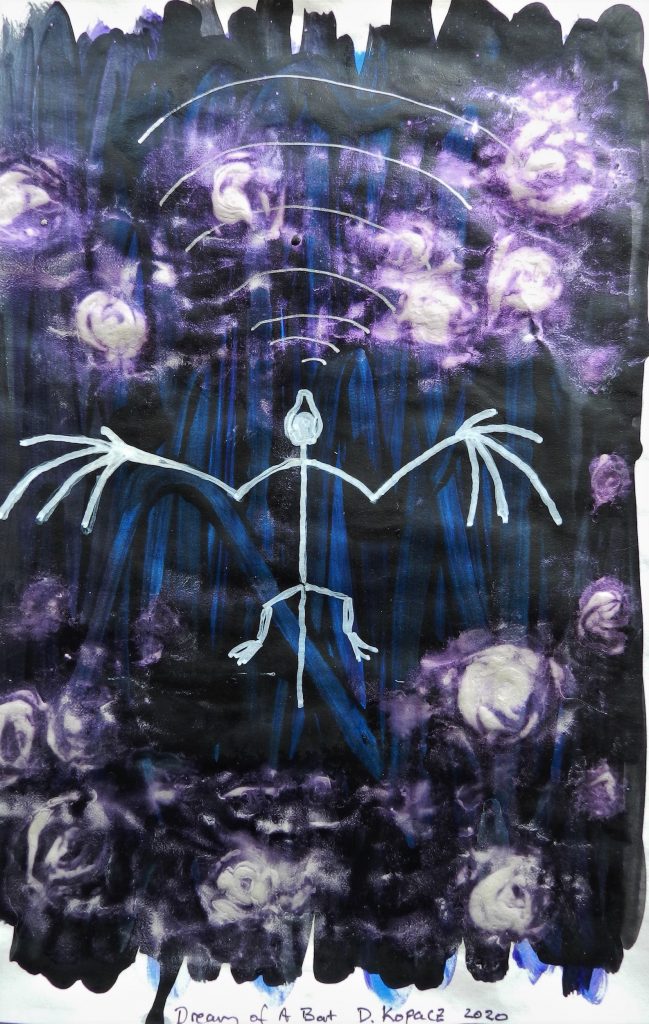 Joseph Rael has been teaching me about visions. He’ll start by saying, “I had a dream or a vision.” Then he will tell me the vision and sometimes say what he thinks it means.
Joseph Rael has been teaching me about visions. He’ll start by saying, “I had a dream or a vision.” Then he will tell me the vision and sometimes say what he thinks it means.
Recently, I had a dream or a vision—I was walking down a deserted alley at night and came across a huge bat skeleton trapped in a wall. My first impulse was fear and a desire to get away from it. I was worried I would be crowned with the coronavirus, COVID-19, from the dead bat. I took a breath, felt the matter of my body, stopped my movement, and sat down next to it.
Maybe it would speak to me or give me some wisdom for these unprecedented times. The bat said nothing. It started trying to get out of the wall. I helped pull it out.
Maybe the bat would thank me and give me some wisdom. The bat was silent, though, like a guru, or maybe just like a dead bat skeleton.
We took off flying.
Through the darkness we were flying. I was learning to use senses I did not know I had. I was learning to feel my way through the darkness, avoiding obstacles I could not see, but I could feel.
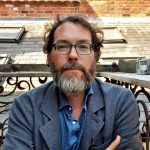
About David R. Kopacz, MD
David R. Kopacz, MD is a psychiatrist working in the primary care clinic at Seattle VA. He is a whole health education champion with the national VA Office of Patient Centered Care & Cultural Transformation and an Assistant Professor at University of Washington. He is the author of three books – Re-humanizing Medicine: A Holistic Framework for Transforming Your Self, Your Practice, and the Culture of Medicine; and with Joseph Rael (Beautiful Painted Arrow) Walking the Medicine Wheel: Healing Trauma & PTSD and Becoming Medicine: Pathways of Initiation into a Living Spirituality.
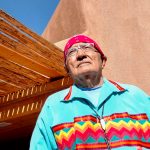
About Joseph E. Rael (Beautiful Painted Arrow)
Joseph E. Rael (Beautiful Painted Arrow), MA, is a visionary healer and artist whose mother was of the Southern Ute people and his father was from Picuris Pueblo. He had a formative vision in the 1980s that led to the creation of over 60 Sound Peace Chambers worldwide and he was recognized by the UN for this global peace work. Joseph is the author of ten books, including, Being & Vibration: Entering the New World, Sound: Native Teachings & Visionary Art, Ceremonies of the Living Spirit, and his two collaborations with David Kopacz.
A Letter to Herman Creek Canyon
A Letter to Herman Creek Canyon
Photos by the Author
A calmness seeps through charred trees, and I am reminded of the Japanese word shibui which recalls “the beauty revealed by the passage of time.” Nothing lasts. Nothing is perfect. It’s been a couple of years since I’ve been with you and your change is extreme. Incinerated by flames on Hades’ wild torch, you’re stripped and lifeless, all cracks and edges. The frozen pale path that switchbacks the canyon wall feels like an edifice of life vanquished.
Exquisite in your cold, naked beauty, you are statuesque and stunning in this mid-winter Sun. Now that ferns and emerald salal are gone, there is no softness in you. Gone too are the rotting logs that slouched under the feathery fir seedlings. How was it for you when the fire tore through? Were there screams? I have heard the cougar scream and the call of a frightened deer. I’ve seen coyotes run and squirrels leap across limb roads. Was it like that here when the Douglas firs sizzled and snapped, and sparks formed fiery tornadoes that whirled off into the wind? When the nests burned, did the crows cry out their losses of home? And what about the snakes on burning bellies and the fate of fluttering butterflies? How was it to stand witness to the devastation?
Now, one year after the fire, the black trees stand tall and straight like up-ended caskets in a crowded morgue. Holes filled with charcoal have replaced your ancient stumps that housed the forest’s tiniest creatures. Ash gray boulders the size of SUVs lie broken and unanchored on bare slopes. Gone are the scolding squirrels, the squawking crows, and the intense woodpecker banging his bill. Gone is the scree of the red-tailed hawk and the owl’s calling in the night. And gone too is the litter of leaves and limbs that cushioned my footfall and nourished the mushrooms and mycelia.
You are naked here, my love, and I admit there is beauty in your bones that I had not seen before. I stop at each switchback to admire your glamorous creek that hurls diamonds and glittering sheets of gauze into the stark unobstructed forest. There’s beauty here like a Stieglitz photograph: chiseled lines and silver reflections on tendrils of fog threading through the cadavers. Shards of winter Sun spotlight your high cascade that splits and splashes and overflows its banks and floats like a bridal train from a place in the clouds.
I must admit, I knelt to kiss you, and I was reminded there is beauty in all the varied spectra of life—from birth to death, imperfection to perfection, ugliness to elegance. There, in the center of the charred sword fern rosette, was a spot of green and next to it an emerging salal leaf. I was witness to sage-green and burnt-orange lichens on a gray rock and, in places near the creek, tiny sprouts emerged from charred mosses. You’re going to be okay. After a year in a coma, you’re showing signs of life and I am witness to your resilience. The resurrection has begun.
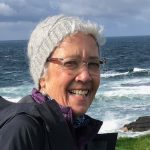
About Ruth Lizotte
Ruth Lizotte, a former K-8 school teacher and organic farmer, lived most of her adult life on a 50-acre farm in Oregon’s Willamette Valley. She raised sheep for meat and wool and had a large vegetable garden. Ruth’s classrooms were filled with living and nonliving things that helped her students better understand their subject matter.
Now retired, Ruth lives in a small apartment in NE Portland and spends much of her time hiking the beautiful Northwest forests and volunteering with Friends of the Columbia River Gorge, where she leads school groups and helps with service projects. When the Eagle Creek fire raged in 2017, Ruth mourned the loss of wildlife habitat and her forest home. When the trails reopened a year later, she was one of the first hikers to return. That hike was the inspiration for “Letter to Herman Creek.”






